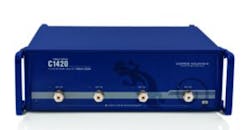CMT founder makes the case for USB vector network analyzers
USB vector network analyzer pioneer Copper Mountain Technologies at the International Microwave Symposium in June in Honolulu introduced ten new products, ranging from the R180 18-GHz cable and antenna analyzer to a Cobalt model that supports frequency extension to 110 GHz. In April, Tektronix entered the market with its 6-GHz two-port, two path TTR500 model, and just before IMS, Pico Technology announced that it has applied its expertise in compact USB instrumentation to offer the PicoVNA 106, a 300-kHz to 6-GHz USB vector network analyzer.
In an email interview, Alex Goloschokin, CMT’s founder and chief revenue officer, made the case for USB vector network analyzers and positioned his company in the newly competitive market.
Rick Nelson: What are the compromises a customer faces when selecting a USB VNA instead of a bench model?
Alex Goloschokin: Compared to other test instruments such as oscilloscopes and spectrum analyzers, VNAs are typically more demanding and complex. Overall, customers are looking for smaller and less expensive VNA solutions but are not willing to compromise on feature set and performance. They are not willing to sacrifice the highly metrological aspects of VNAs and demand both accuracy and traceability.
In any analyzer, including the VNA, the location of the processing module (aka computer) is not relevant to its performance. A VNA’s performance is driven by many other factors, but not whether the computer is housed in the same location as the measurement module. Consequently, USB VNAs can perform as well as conventional VNAs and offer many advantages not present in traditional instruments:
- Use of current technology. Users have the ability to easily upgrade as technology evolves.
- Lower total cost of ownership. When something breaks in the VNA, most commonly it is computer-related—a hard drive died, a screen got broken, or it needs more memory.
- It is critical for engineers to have access to equipment that allows them to do their best work. Our price point enables engineers to have more VNAs at the same level of investment. Functions that are typically high-cost add-ons in conventional VNAs come standard in our products, including time-domain with gating. Instruments can be easily shared and used with multiple PCs.
- USB VNAs are significantly smaller than traditional instruments since measurement module is separate from computing module and can even be incorporated as a built-in module into larger systems.
- Speed: Since test automation scripts run on the PC, not on the VNA, there’s no latency in data transfer of test results between various software applications, making it is easier to integrate a USB VNA into a test system.
RN: I believe Copper Mountain was the first company to market a USB VNA, is that correct?
AG: Copper Mountain Technologies was the first company to offer a metrology-grade USB VNA that delivered accurate performance in USB form factor, for which it was awarded Frost & Sullivan Global Leadership in Innovation Award in 2015. It was also the first company to offer a 1-port VNA (aka cable and antenna analyzer) that can connect directly to DUT, without a requirement for test cable, thus reducing uncertainties associated with the use of a test cable (U.S. Patent 9,291,657).
RN: Some other companies have recently introduced USB VNAs. What makes your products unique in the competitive field?
AG: CMT has spent over 10 years working on the metrological aspects of its VNA solutions to meet users’ high expectations, keeping instrument performance a priority. The company has a dedicated metrology group that focuses on measurement accuracy and stability during the design phase of the instruments and closely monitors production in order to guarantee that solutions perform within the specified uncertainty limits.
Over the past few years, the company has expanded its product portfolio of USB VNAs to include various models of different performance, size, and price points to accommodate the needs of a variety of customers. Its portfolio of VNAs includes four 1-port VNA models (also known as reflectometers or cable and antenna analyzers) from 1 MHz to 18 GHz. Its Compact product line, which scores high in form factor while still providing sufficient performance for many customers, includes seven models from 9 kHz to 8.5 GHz. Finally, CMT’s flagship Cobalt line includes 12 models ranging in frequency from 100 kHz to 20 GHz. The company also offers the CobaltFx system, which is a high-performance, yet affordable, millimeter-wave solution up to 110 GHz, and is the result of its partnership with Farran Technology.
CMT puts a great emphasis on providing outstanding support and developing customized solutions that fit the application. Without a computer inside the VNA box, CMT is not limited by a computer or screen size, dials, and buttons. CMT can easily move modules and PC boards around, thereby changing the form factor, type, and location of connectors to conform to specific customer requirements in terms of form factor or dimensions.
In 2017 industry analyst Frost & Sullivan awarded the Product Leadership Award in the USB VNA category for the first time. The researchers concluded that CMT’s strong and established USB VNA offering coupled with superior customer support, software development, and customization has earned it the 2017 Frost & Sullivan Global Product Leadership Award.
RN: I believe that at IMS 2016 Copper Mountain was demonstrating Cobalt in conjunction with Farran Technology’s mmWave frequency extenders. Are you still working with Farran?
AG: The CobaltFx system in partnership with Farran is now in use in telecommunications and automotive sectors and continues to draw strong interest from those who manufacture and test mmWave antennas and develop automotive radar and other systems
RN: Did you identify any key industry trends at IMS 2017 in Honolulu, and how were your new products received by attendees?
AG: The imminent move of many IoT technologies from research to commercialization is expected to drive the demand for lower cost instrumentation over the next five to ten years. With the market moving IoT products from research to commercialization, customer requirements for reliability are increasing, along with demand for smaller, lower cost, and more automated instruments.
Materials testing is a growing application of VNAs, particularly USB VNAs, which can be incorporated into test systems due to their size and portability. A number of attendees at IMS were very interested in an airplane canopy testing system demonstrated at CMT’s stand by Compass Technologies, which incorporated one of CMT VNAs.
Editor’s note: Those of us who missed IMS in Honolulu will have an opportunity to see CMT’s product lineup at EDI CON USA September 11-13 in Boston.


